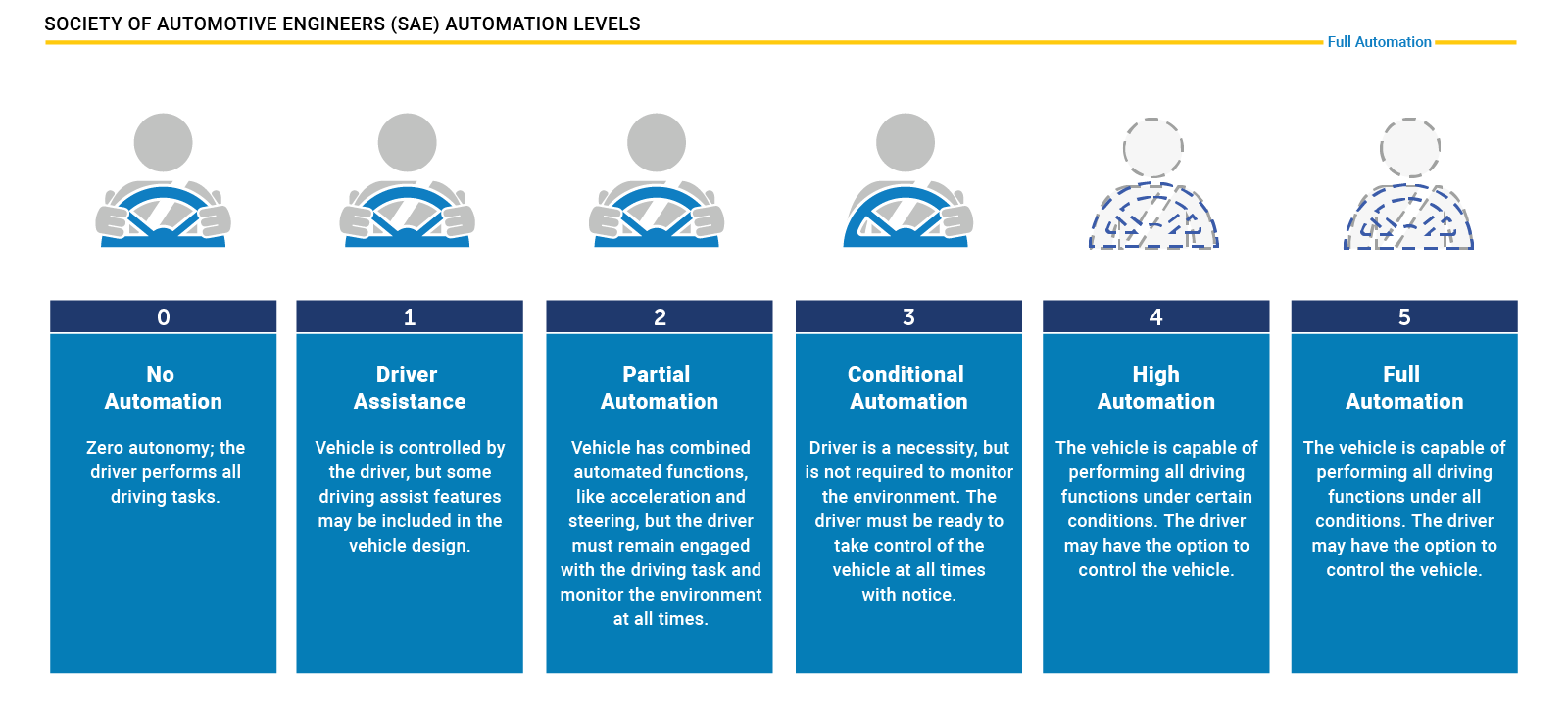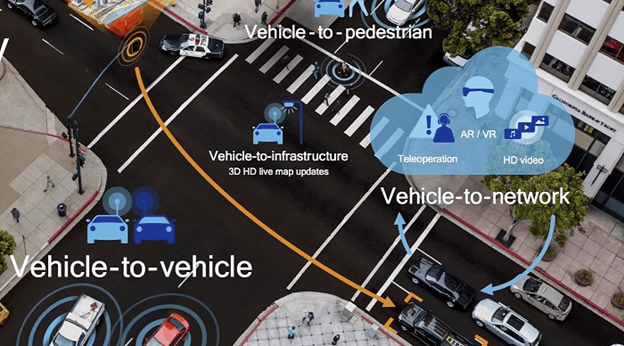Resources

Stay up to date with the latest PCAutomotive news and events, explore our webinars, and study our expert research.
We highlight the most important and valuable trends in the automotive security industry
2022-06-15
The 5 Levels of Autonomous Driving. Where are we now?
Gianfranco Vinucci
Security and legislation gain more importance
Nowadays, autonomous cars, also known as driverless vehicles, are becoming more and more of a reality. The advances in, and adoption of, sensor technologies like LiDAR, computer vision and high-precision positioning have pushed the development of these self-driving systems. This adoption also gets strong support from business leaders that are anticipating significant profits from introducing high-tech gadget-like cars into series production.
Vehicle automation, however, comes at a price. It creates increased complexity in the internal systems of the car as well as in the road infrastructure. In addition, this innovation requires secure cloud services and data exchange protocols, more on-board computers, and new software solutions.
To make things easier, the Society of Automotive Engineers (SAE) created a hierarchy of driving autonomy already accepted by the automakers, so you can navigate the world of modern cars. There are five levels of autonomous vehicles in total – from the most basic Level 1 to the most advanced Level 5.

Every new technology that advances car autonomy further transforms the vehicle as we used to know it into an internet-connected computer-on-wheels. This transformation poses huge security and privacy risks. All these new risks create a need for cooperation on the technological and legislation level. Collaboration between manufacturers, expert associations and national governments becomes of paramount importance.
Level 1. Helping the driver who is still in full control
The first step towards driving automation is a single element of the driving system controlled by isolated software algorithms utilizing data from sensors and cameras. In fact, it has been here with us for quite a long period of time. Mercedes-Benz exploded the market with their pioneering cruise-control back in late 1990’s and Honda presented lane-keep assist in the Legend in 2008.
The moment one control was delegated to an onboard computer kicked-off the new era of car digitalization.
When you say software algorithms, you think of updates, don’t you? The real paradigm shift in understanding of vehicle safety and security in the new digital era happened when the car became connected to the worldwide web like a plain smartphone. And the cyber criminals get a new target.
Level 2. Driver-assist features
Basically, this is where we are now, with most worldwide automakers offering different autopilot options for their premium models. Mercedes’s Drive Pilot, Tesla's Autopilot, Cadillac's SuperCruise, Honda’s Sensing System and others take over control of multiple vehicle functions to assist the driver. These systems can automatically slow down for corners ahead, maintain a safe distance from the car in front and continue moving when a traffic jam clears up without any input from the driver.
Increases in software complexity and the number of functions controlled by computers understandably creates security burdens. The control of the automatic driving process is based on data collected by sensors and cameras. This means that if someone sends incorrect data to the system, the decisions made by the machine could be wholly wrong, translating to physical danger for people in cars or pedestrians.
Tesla's Autopilot and Full Self-Driving Capability. This functionality includes speed control to match the surrounding traffic, steering assistance for clearly marked lanes, navigating the planned route with automatic turn signal, taking the correct exit on the high-way, parallel or perpendicular parking and more. While the automaker declare this system enhances safety and reduces drivers’ workload, they still insist on the driver's responsibility to stay alert – keeping hands on the wheel and eyes on the road to maintain full control of the car.
However, this level of driving autonomy is already enough for malefactors to ruin the driver’s plans and create a physical threat to the driver as well as the surroundings. Researchers from Regulus Cyber staged a remote spoofing attack targeting the auto-navigation system of a Tesla Model S and Model 3 and managed to take control away from the driver and suddenly steer the electric vehicles off the road.
You know why it is so scary? The problem with Tesla’s Autopilot was not the fault of their constructors. The vulnerability was found in GNSS (Global Navigation Satellite System); every autonomous car in the world with GNSS could be exploited. This shows the scale of the automotive cybersecurity challenge. Only combined efforts from the whole ecosystem of the manufacturers, parts suppliers and service providers can provide a safe driver-assistant feature.
Level 3. Conditional automation: vehicles can react accordingly and make decisions on their own
Now the world is quickly approaching the next level of driving autonomy, driving hands-free for a limited period of time. We expect Level 3 vehicles to not only provide Level 2 cruise control – maintaining a safe distance from the car in front – but to also be able to independently perform evasive maneuvers in case of emergency – all without physical intervention from the driver.
To a certain extent, Level 3 has already been in place thanks to the Honda Legend, available for lease in the Japanese home market and equipped with an advanced Honda Sensing system.
While technology and related cybersecurity challenges are racing each other, the real showstopper for the Level 3 autonomy appeared to be a legal basis. Audi A8 came close to having Level 3 autonomy in 2017, but the automaker quickly abandoned its plans due to conflicting legislations. Nevertheless, Germany became the first country to approve the use of Level 3 driving aids, and Mercedes-Benz is the first manufacturer to put conditionally automated driving into series production in Germany in May 2022. Their updated DRIVE PILOT system offers conditional driving automation that enables the vehicle to react to its environment and make decisions without urging the driver to take back control.
According to Mercedes-Benz, the automaker continues to work with authorities in the USA to bring the first Level 3 vehicles to American roads.
Do we currently comprehend the right balance between the security of software algorithms deciding to turn the steering wheel and the legal complexity of sorting out who should be held responsible in case of a road accident? It seems to be the case since we have already taken the first steps towards Level 3 autonomy on our roads.
Level 4. Fully-autonomous vehicles in designated areas
The next step in driving autonomy, according to SAE, would be to implement specifically designed and controlled areas where autonomous vehicles can entirely drive themselves. These locations are expected to appear by the middle part of the decade.
The algorithms of hands-free driving and communication between the car and infrastructure and other road traffic participants will be in place but only fully available in these designated Level 4 autonomy zones.

In the beginning, these Level 4 vehicles will likely be offered as either public transport or car sharing vehicles. It is unlikely that Level 4 implementation will reach individual passenger vehicles in the near future. This will also create much needed priority rules within the city infrastructure to public transportation and emergency vehicles.
Someone must be thinking about the entire process, right? The responsibility of road safety and traffic now falls entirely on computer systems. The security of vehicle-to-everything (V2X) communications and robust driving algorithms are of utmost importance. Security assessment procedures need to become a part of the process to ensure true safety and comfort for drivers and pedestrians. Infrastructure, applications, communication channels – all elements should become the subject of thorough testing and regular security assessments.
Level 5. Self-driving cars everywhere
Level 5 is simple to describe. It is a full self-driving car that can go anywhere at any time following the user’s command. These vehicles will not need a driver's attention or intervention at any time. The car design will also likely change significantly: the steering wheel and the brake/acceleration pedal might become things of the past.
Are we ready for the future? Let’s just say, we are on our way. By this time, the industry will have to introduce automotive cybersecurity standards and procedures and also support the technology with the proper regulatory legislation.
